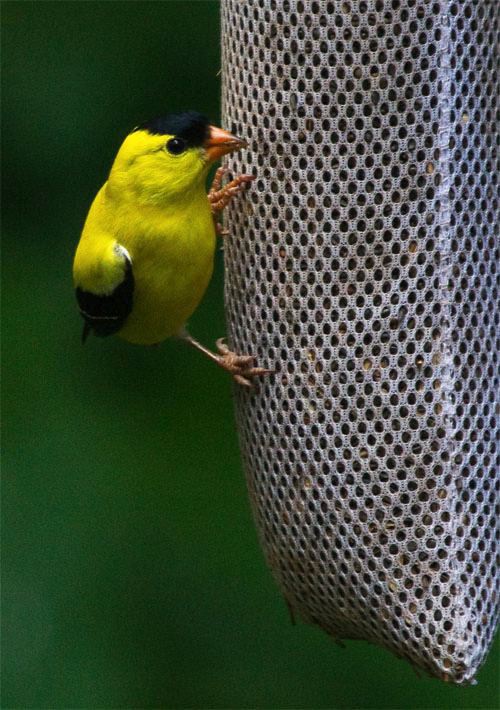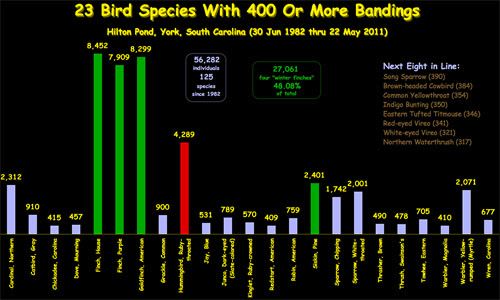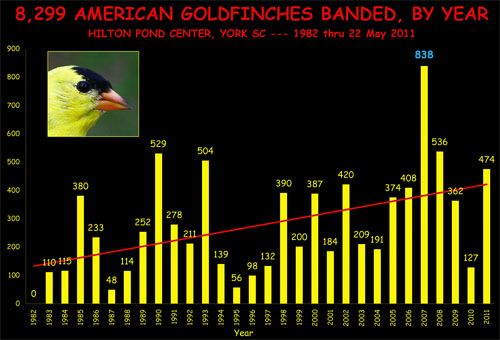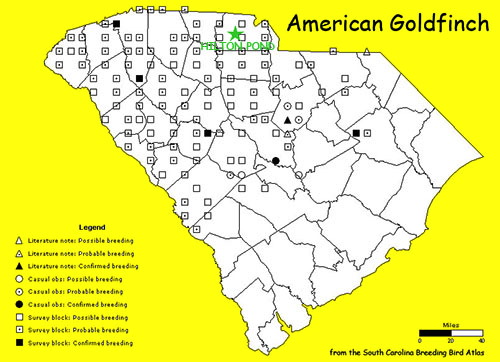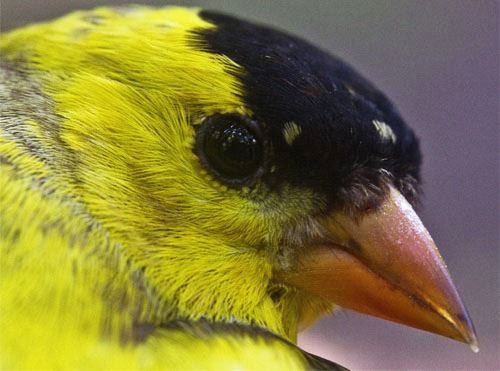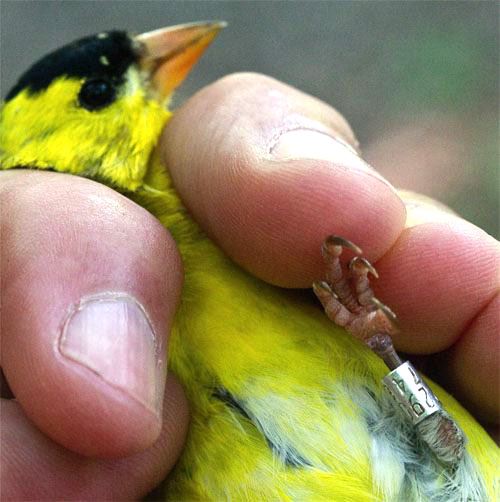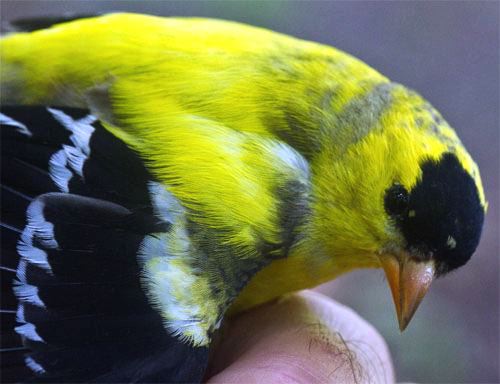|
|
|||
|
THIS WEEK at HILTON POND
15-22 May 2011 INSTALLMENT #511---Visitor # (Back to Preceding Week; on to Next Week) |
|
All maps, charts, text & photos © Hilton Pond Center AMERICAN GOLDFINCHES REVISITED--AND REVISITING We can't help but pay attention to American Goldfinches (AMGO) at Hilton Pond Center. They're exceptionally colorful--especially when males don their bright breeding attire each spring--and they're entertaining in their antics at thistle socks we hang at our feeding stations (above). Although we've written about goldfinches on several occasions, encounters with an especially old one--plus a distant recapture--prompted us to write this week about "American Goldfinches Revisited--And Revisiting." We've gotten intimately familiar with American Goldfinches, Carduelis tristis, through the years--mostly because they've become the second-most-commonly banded species at the Center since we started our long-term natural history research in the Summer of 1982. As of this week we've handled 8,299 AMGO (see chart above)--exceeded only by 8,452 House Finches (HOFI). With the steady decline of local HOFI in the past decade, we anticipate goldfinches will rise to the top of the list in the next year or so--unless the upcoming winter brings a big influx of Purple Finches (currently #3). As noted by the rising red trend line on the chart just above, American Goldfinches are indeed on the increase at Hilton Pond Center. Except for the late-1980s and mid-1990s when we were away from the Center for all or most winters, we've typically banded at least 200 AMGO per year, with an annual average of 277 for the 30-year period. In three of those years we handled more than 500 goldfinches--and likely will do so in 2011--while in 2007 we had an amazing all-time high of 838. We're not sure what happened last year with a near-record low of 127 AMGO, but it may have had to do in part with our taking citizen scientists for hummingbird research in Central America while many goldfinches were feasting on thistle and sunflower seeds around Hilton Pond.
All maps, charts, text & photos © Hilton Pond Center One trend that doesn't show on our charts is a significant increase in the number of American Goldfinches we're now seeing at the Center during the breeding season. Historically, AMGO descended in late fall into the Carolina Piedmont, mostly as migrants from the species' primary breeding grounds in the northeastern and north central states. (See USGS map above, on which greatest breeding density is indicated by darker shades of red.) Goldfinch nesting had been reported from scattered locales in the South Carolina Upstate but the area was not known to host a substantial breeding population; furthermore, most of our Hilton Pond AMGO departed by mid-April for more northerly nesting grounds.
All maps, charts, text & photos © Hilton Pond Center Even though a map from South Carolina's Breeding Bird Atlas (above)--last updated in 1995--shows no confirmed goldfinch breeding records for York County in which Hilton Pond is located, over the past decade we've captured more and more midsummer American Goldfinch females with well-developed incubation patches; we've also banded increasing numbers of recent fledglings. Likewise, it's no longer uncommon to see a whole family of goldfinches visiting our seed feeders in late August or early September--well before the anticipated arrival of any fall migrants from up north. It certainly appears that American Goldfinches might be expanding their breeding range in the Palmetto State or at least concentrating breeding numbers in the Piedmont, so we'd be quite interested in hearing about nesting records in South Carolina Lowcountry counties that are unmarked on the map above. (Also please let us know if you get a photographable nest within York County in 2011 or thereafter; send your comments to INFO.)
All maps, charts, text & photos © Hilton Pond Center Although it would have been unusual 20 years ago to see American Goldfinches in mid- or late May at Hilton Pond Center, they were certainly here this week when we banded three males and two females. We also trapped one male (above) that was already banded.
All maps, charts, text & photos © Hilton Pond Center This bird's aluminum band was rather worn with dirty numerals (above)--sure signs he hadn't acquired the band very recently. As we brought the goldfinch to the banding table in the Center's old farmhouse we were eager to check our records for his number (2290-67480) and had to go back further than we expected--all the way to 20 April 2005. Curiously, we had caught him in the very same trap as a second-year bird and now he is classified as seventh-year. This isn't a longevity record for the species--the federal Bird Banding Lab lists an ancient female American Goldfinch that was 10 years 5 months when found dead--but it's certainly the oldest AMGO we've had at Hilton Pond. A further check of our data revealed we had recaptured this bird twice before on 20 February 2006 and again on 17 April 2009.
All maps, charts, text & photos © Hilton Pond Center To be honest, had this particular goldfinch not been banded we might not have aged it accurately. As shown in the photo above, he hadn't quite completed his molt into breeding plumage--note the olive-gray feathers on the nape--and his epaulets were not the bright yellow edged in white we would expect in a bird at least three years old. |


